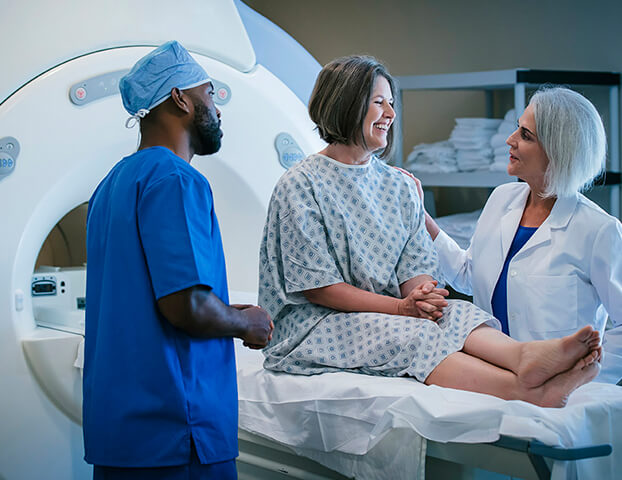Diagnostic Imaging Technician-MRI
Navigating the Hiring Process
We're here to support you!
Having trouble with your account or have questions on the hiring process?
Please visit the FAQ page on our website for assistance.
Need help with your computer and browser settings?
Please visit the Technical Information page for assistance or reach out to the web manager at kp-hires@kp.org.
Do you need a reasonable accommodation due to a disability?
A reasonable accommodation is any modification or adjustment that enables you to fully participate in completing the following:
- Online Submissions
- Pre-Hire Assessments
- Interview Process
Please submit your accommodation request and an HR Representative will contact you.
Under general supervision and utilizing Magnetic Resonance Imaging equipment, produces diagnostic quality cross-sectional images of the human anatomy and vasculature for diagnostic and/or therapeutic purposes. Performs MR imaging protocols and operates hardware and technical parameters in order to maximize MR image quality and acquire images that can be utilized by physicians in order to diagnose diseases. Provide functional direction to assigned staff.
Essential Responsibilities:
- Upholds Kaiser Permanente's Policies and Procedures, Principles of Responsibilities and applicable state, federal and local laws.
- Responsive to the needs of others by exhibiting professional behavior toward health plan members and co-workers.
- Explains procedures to patients to reduce anxieties and obtain patient cooperation.
- Demonstrates an understanding of the cognitive, physical, emotional and chronological maturation process in delivery of services to patients of the age group served.
- Identifies the impact of cultural diversity and lifestyle choices on patient condition and makes accommodations for such differences.
- Utilizes proper body mechanics.
- Documents clinical activities in a timely, comprehensive, and accurate manner.
- Observes all organizational, regional, medical service area and Diagnostic Imaging Department policies and procedures.
- Maintains standards of professional behavior established to enhance quality of service.
- Utilizes effective communication skills.
- Demonstrates behavior that meets established standards for professionalism in all interactions with patients and staff.
- Maintains equipment, supplies and work area in accordance with department guidelines.
- Provides training and orientation to new MRI technologists and training of MRI technologists.
- Assists other technologists as needed.
- Performs MRI studies according to established imaging protocols including but not limited to placing specified coil close to the area of interest.
- Explains to patients the magnetic resonance imaging procedures, address patient concerns, and, exhibits high degree of tact, courtesy and poise when interacting with patients, staff and visitors.
- Ensures patient and staff safety which includes explaining safety protocol, requesting removal of hazardous metal objects, and, alerting staff the danger of carrying metal around magnet.
- Performs all routine aspects of MRI procedures, including but not limited to QC, start-up procedures, signal-to-noise test scans, program/sequence selection, contrast injection, and image processing.
- Operates various x-ray and imaging control consoles, portable units, tube assemblies, lock systems, collimators, filters and tubes in order to perform diagnostic radiographic procedures and exams including - but not limited to - gastro-intestinal exams, plain radiography in areas such as operating room, urology and emergency department.
- Operates auxiliary imaging equipment such as - but not limited to - tomographic units, Buckies, image intensifiers, spot film devices, video monitors, CR equipment, digital imaging, C-arms and portable units.
- Prepares and administers the appropriate oral, intestinal and I.V. contrast media or as appropriate, assists the radiologist with I.V. Contrast administration.
- Ensures that correct and required patient identification information and left or right marker appears on all images.
- Centers tube and film to area of interest.
- Utilizes appropriate photo-timing, mill-amperes (MA), kilovoltage (KVP), seconds, distance, collimation, intensifying screens, film speed and grids in order to produce diagnostic quality images which demonstrate the area(s) of interest and exhibit acceptable contrast, density and detail.
- Explains the exam/procedure to the patient in order to solicit cooperation and obtain patient understanding.
- Assesses the patients history and overall condition and makes the necessary modifications in technique and/or positioning to compensate for pathology or other considerations.
- Selects appropriate coil for requested exam and positions coil (i.e., head coil or knee coil) to demonstrate area of interest and to obtain maximum transmit and receive signal, selects monitoring devices and support equipment as required by patient condition.
- Obtains optimum MRI imaging throughout the entire region of interest by selecting and applying imaging parameters such as but not limited to: field of view, number of slices, slice thickness, number of excitations (acquisitions), repetition time, echo time, phase direction, frequency direction, matrix and gap between slices.
- Performs tuning procedures, utilizes appropriate protocols for producing optimal images.
- Identifies artifacts if present and rectifies problems.
- Recognizes the need for additional sequences, changes in protocols and the need for paramagnetic contrast studies based on patient pathology, physical condition or sub-optimal image quality.
- Apply MR interventional, magnetization transfer imaging (MTI), echo planar, spectroscopy, maximum intensity projection, cine and perfusion/diffusion imaging.
- Enters into computer system specific data such patient history, anatomical area to be scanned, orientation specified.
- Keys commands to specify scan sequences in computer and adjusts transmitters and receivers, views images of area being scanned on video display screens to ensure image quality.
- Archive images to PACS.
- Utilizes a knowledge of proper patient/part positioning and department protocols to obtain routine and other indicated views required for standard projections.
- Observes all required radiation safety/protection regulations and standards in order to minimize dose and avoid/minimize repeat films.
- Uses lead shielding and collimation as appropriate.
- Critiques images for diagnostic qualities and other properties such as artifacts and appropriately consults with supervisor and/or radiologist to clarify any areas of uncertainty.
- Completes requisition with all required and pertinent information.
- Complies with all required continuing education standards.
- May perform other duties as required and assigned.
- Minimum three (3) years of experience within the last twelve (12) months in radiologic technology, including one (1) year of recent experience in magnetic resonance imaging.
- May substitute one (1) year MRI experience with successful completion of the departments formal MRI training program.
- Graduation from a JRCERT approved school of Radiologic Technology.
- High School Diploma or General Education Development (GED) required.
- American Registry of Magnetic Resonance Imaging Technologists Certificate OR American Registry of Radiologic Technologists Certificate - Magnetic Resonance Imaging
- Certified Radiologic Technologist - Venipuncture Certificate (California)
- Basic Life Support from American Heart Association
- Ability to demonstrate knowledge of and to utilize the theories, principles, practices and techniques of radiologic technology.
- Ability to demonstrate knowledge of and utilize the principles, theories, practices, and techniques of basic and advanced magnetic resonance imaging including clinical exams, physics, MRI safety, cross-sectional anatomy and patient care.
- Minimum three (3) years of clinical experience as an MRI technologist in an acute care medical center, preferred.
- Computed Tomography experience, preferred.
- Advanced Certification in Magnetic Resonance Imaging issued by the ARRT (MR), preferred.
Notes:
• Tasks include, but NOT limited to QA, Crash Cart checks, Protocol exams, CIED/Pacemaker procedures (MRI Safe Mode), scan Ped Sedation patients.
Kaiser Permanente is an equal opportunity employer committed to a diverse and inclusive workforce. Applicants will receive consideration for employment without regard to race, color, religion, sex (including pregnancy), age, sexual orientation, national origin, marital status, parental status, ancestry, disability, gender identity, veteran status, genetic information, other distinguishing characteristics of diversity and inclusion, or any other protected status.
For jobs where work will be performed in unincorporated LA County, the employer provides the following statement in accordance with the Los Angeles County Fair Chance Ordinance. Criminal history may have a direct, adverse, and negative relationship on the following job duties, potentially resulting in the withdrawal of the conditional offer of employment:






